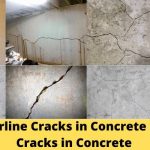Misconceptions of Structural Action
Design procedures often include simplifying assumptions as to the way, in which the final structure will behave. It the designer does not ensure that the structure can, in fact, behave in the assumed way, cracking occurs to the extent necessary. A common example is when moment free condition is assumed and not achieved. A wall-floor joint in a 1 Million Liter water tank is shown fig. In the design of the tank, this joint had been assumed to behave as a pin, but the face marked bitumen paint did not have enough separation.
As a result, when the tank wall rotated under water load, the faces came into contact and the corner behaved as a knee-joint, transmitting moment. The compression components of this moment produced a diagonal tensile
Resultant, which caused a substantial piece of un-reinforced concrete to spall off, as shown in figure and exposed reinforcement then corroded.
When connected members have very different rigidities forces may tend to migrate from the path, provided by the designer into an alternative rigid member.
The primary beam shown in the figure below as to transfer the negative moments from the secondary beams, to the supporting columns.
As the columns and the primary beams are both stiff members, this transfer involves a torque in the primary beam, for which torsion reinforcement is needed. When this reinforcement was omitted from the design, helical cracks appeared.
Reinforcement Detailing
Inadequate detailing of reinforcement is a wideparead cause of cracking and particularly of those severe cracks, which affect the limit state of collapse
Designers given the opportunity, learn from experience and in many organizations, this source of trouble is steadily reduced. Members, which appear to be particularly susceptible to severe cracking as a result of insufficient steel or broadly arranged steel, are those which carry local loads, such as corbles, supports for bridge bearings, walls supporting column bases, pre-stressing anchorages and column capitals.
Conventional drawings tend to ignore the physical size of the bars, and the limitations on bend shape in practical reinforcing. Equally important is the need, to ensure that the steel is incorporated in the way it was designed.
Extensive tests on corbles identified 6 different failure mechanisms, which may occur and against which, reinforcement is needed. An arrangement of reinforcing which takes account of these potential failure modes in shown in the figure below. A very common source of trouble arises from locating the outer edge of the bearing, beyond where the steel can possibly be located. The designer should ensure that with normal tolerances on steel bending and placing, there is still adequate steel located outside the edge of the bearing, when it is located at the extreme of its tolerance.
Some arrangements of reinforcement actually cracks, and these should be carefully avoided. For example severe cracking can be seen, when all the top bars in a slab are terminate at the same cross section.
Construction Errors
Construction & supervision deficiencies are the major cause of defects, leading to cracking. It has been found that 36% of the defects were due to these causes. A well-known expect on structural failures said that, he never found a failure caused by poor concrete, but he had never investigated one that did not contain poor or interior concrete. This comment related to collapses of structures, but when the definition of failure is extended as we are doing here, the quality of concrete does become much more important. For example, the protection afforded to steel is greatly of concrete depended on the compaction & curing of the cover concrete.
Survey revealed that construction defects could be grouped into 4 classes.
A. Deficiencies in the control of concrete materials, batching & mixing
· Use of salt water as mixing water
· Excess fines in the aggregates
B. Inadequate preparation before concreting.
· Salt water contamination of reinforcement
· Lack of cover to reinforcement
C. Inadequacies of placing & subsequent treatment
· Plastic cracking & settlement cracking
· Lack of curing
D. Faults of construction planning &procedure
· Overloading of members by construction loads
· Loading of partially constructed members
· Differential shrinkage between section of construction
· Omission of designed movement joints
· Unexpected behavior and restraint during prestressing



Comments are closed